- MultiBoot
- Windows 10, Windows 11
- 01 July 2024 at 13:14 UTC
-

- 1/7
Want to test Windows 11 without leaving Windows 10? So here is how to create a multiboot with Windows 10 and Windows 11 installed on virtual hard disks (VHDX).
To learn more about the operation, advantages and disadvantages of native boot (VHDX), refer to our article: Windows 7 / 8 / 8.1 / 10 / 11 - Native boot to VHD/VHDX.
Since UEFI and Secure Boot are Windows 11 prerequisites, this tutorial will only show you how to configure multiboot in EFI mode and not in LEGACY BIOS mode.
Unlike our other multiboot tutorials based on VHD or VHDX virtual hard disks where we explained the 2 possibilities (EFI and LEGACY BIOS).
- Configuration used
- Create a virtual hard disk (VHDX) to install Windows 10 on it
- Copy Windows 10 installation files to VHDX virtual hard disk
- Partition disk 0 of your computer
- Create boot files and boot entry for Windows 10
- Installing Windows 10
- Create a virtual hard disk for Windows 11
- Install Windows 11 on virtual hard drive
- Add boot entry for Windows 11
- Installing Windows 11
- Manage the boot menu on Windows 11 (to change the default OS)
- Manage the boot menu on Windows 10 (to change the default OS)
1. Configuration used
For this tutorial, we used a computer with:
- a 256 GB SSD on which Windows 10 is currently installed.
- a 500 GB hard drive will temporarily store your 1st virtual hard drive.
But, this will no longer be necessary once the multiboot has been created. You can therefore store your personal data (documents, ...) there.
In our case, your computer is configured to boot in UEFI mode with secure boot enabled (supported by Windows 10 and required by Windows 11).
Note: the version of Windows currently installed on your computer is of little importance.
Indeed, disk 0 containing in particular the "C" partition where Windows is currently installed will be completely erased during this tutorial.
However, you must currently be on Windows 8 or later for the commands used in this tutorial to work.
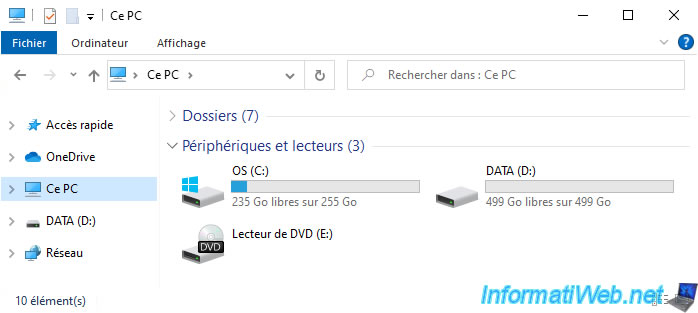
To better see what will be erased in this tutorial, open File Explorer and right click "Manage" on "This PC".
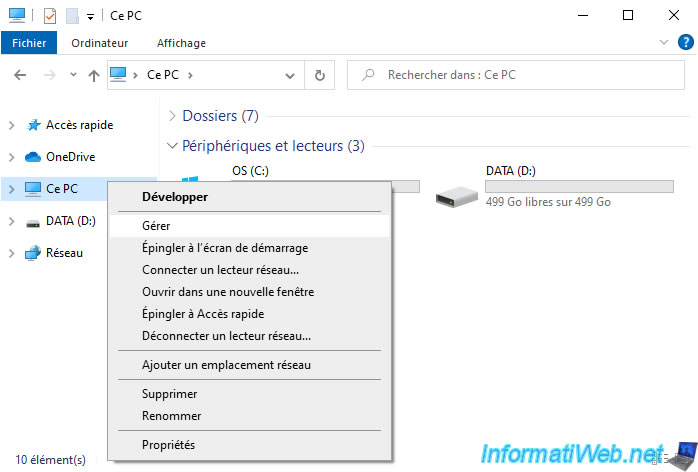
In the "Computer Management" window that appears, go to the "Disk Management" section.
Important : the "Disk 0" displayed here will be completely erased during this tutorial.
Remember to back up the data on this hard disk to another disk or to a USB key (if applicable) before continuing with this tutorial.
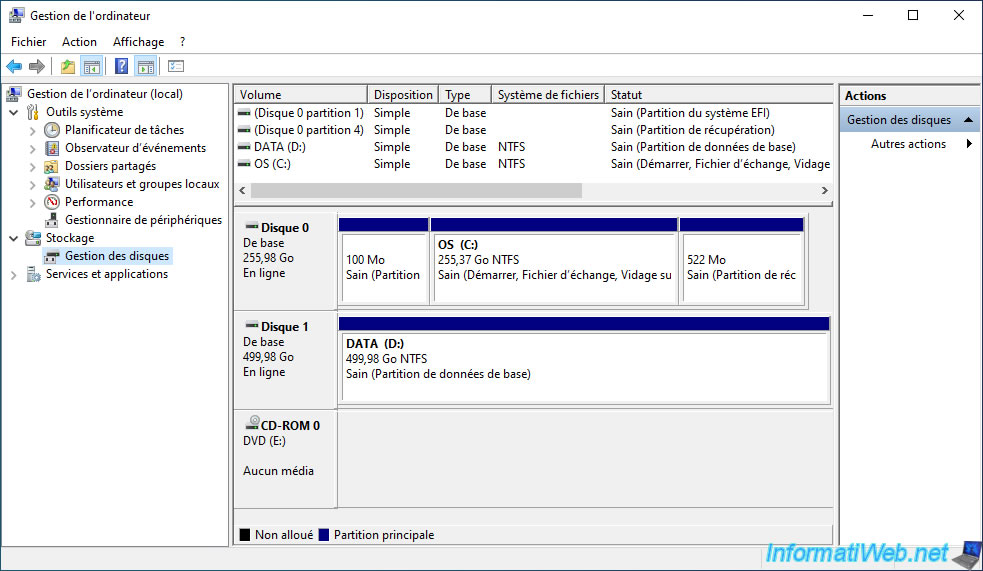
Right-click "Properties" on the "Disk 0", then go to the "Volumes" tab.
As you can see, in our case, Windows 10 had been installed in EFI mode since the partition type is "GUID Partition Table (GPT)".
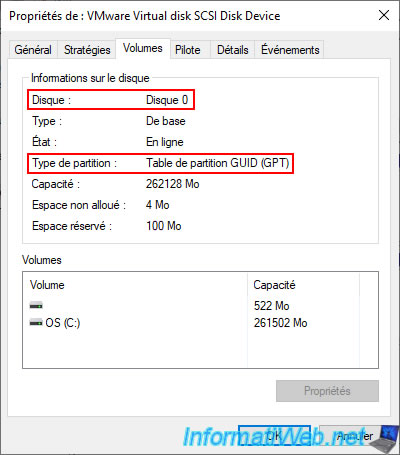
2. Create a virtual hard disk (VHDX) to install Windows 10 on it
To get started, open a command prompt as an administrator.
To do this, open the Windows start menu and type "cmd".
Next, for the "Command Prompt" program that will be selected automatically, click "Run as administrator".
On other versions of Windows, you will need to right-click "Run as administrator" on the "cmd.exe" or "Command Prompt" program that will be offered.
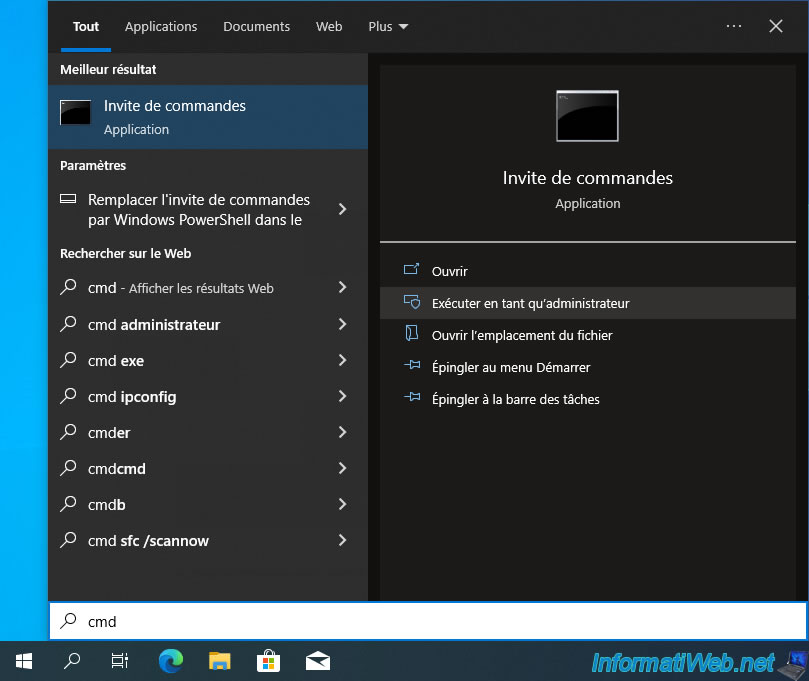
In the command prompt (cmd.exe) that appears, launch the "DiskPart" tool.
Batch
diskpart
Plain Text
Microsoft DiskPart version 10.0.19041.610 Copyright (C) Microsoft Corporation. On computer : InformatiWeb-PC DISKPART>
Create an 80 GB virtual hard disk in VHDX format on a partition of your 2nd hard disk.
In our case, our 2nd hard drive has a single partition named "DATA (D:)".
Note: to avoid data corruption and benefit from better performance, Microsoft recommends using a fixed-size virtual hard disk.
If you want to know more about the different types of VHD/VDHX virtual hard disks, refer to step "5. Types of virtual hard disks" of our article about native booting in Windows.
Batch
create vdisk file=D:\win10.vhdx maximum=81920 type=fixed
Wait while creating the virtual hard disk.
This may take a while depending on your hard drive and computer performance.
Plain Text
11 percent completed
Once the virtual hard disk has been created, this will be displayed:
Plain Text
100 percent completed DiskPart successfully created the virtual disk file.
Attach your virtual hard disk so Windows can use it.
Batch
attach vdisk
Plain Text
100 percent completed DiskPart successfully attached the virtual disk file.
Create a single primary partition on this entire virtual hard disk.
Batch
create partition primary
Plain Text
DiskPart succeeded in creating the specified partition.
Format this partition as NTFS (default) and name the partition "Windows 10 (VHD)".
Batch
format quick label="Windows 10 (VHD)"
Plain Text
100 percent completed DiskPart successfully formatted the volume.
Assign the letter "V" to this new partition of your virtual hard disk.
Batch
assign letter=V
Plain Text
DiskPart successfully assigned the drive letter or mount point.
Quit DiskPart.
Batch
exit
In the file explorer, go to the partition of your 2nd hard drive and you will see that an 80GB "win10.vhdx" file has been created.
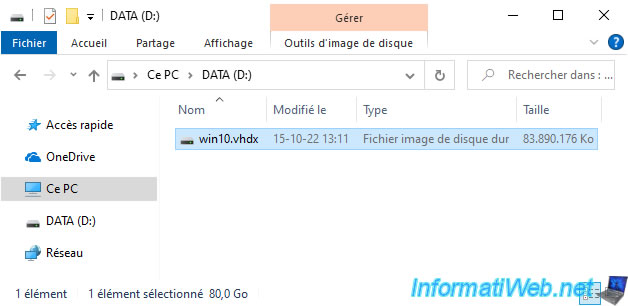
If you display the properties of this "win10.vhdx" virtual hard disk, you will see that it already takes up 80 GB on your physical hard disk.
This is because you have created a virtual hard disk with a fixed size. The space required for the maximum size of this virtual hard disk has therefore already been preallocated.
This will save you from a brutal Windows crash if the space begins to run out on the physical hard drive. It also avoids data corruption and it improves the performance of this virtual hard disk.
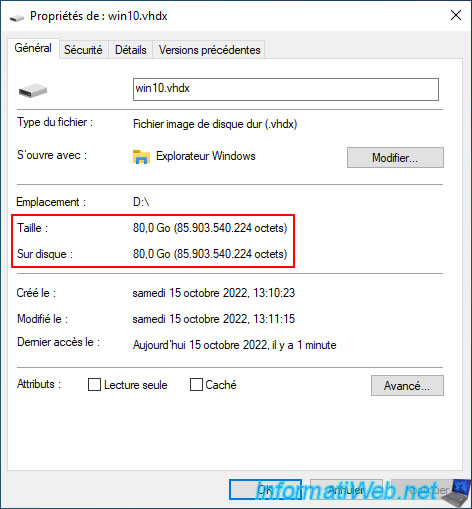
If you go to "This PC", you will see that a "Windows 10 (VHD) (V:)" partition has appeared.
This is the partition created in your "win10.vhdx" virtual hard disk.
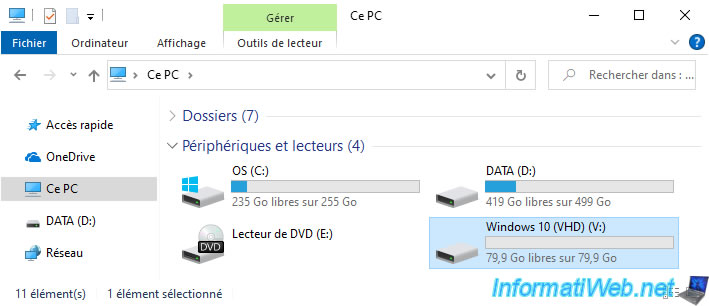
If you enter this partition, you will see that it is currently empty.
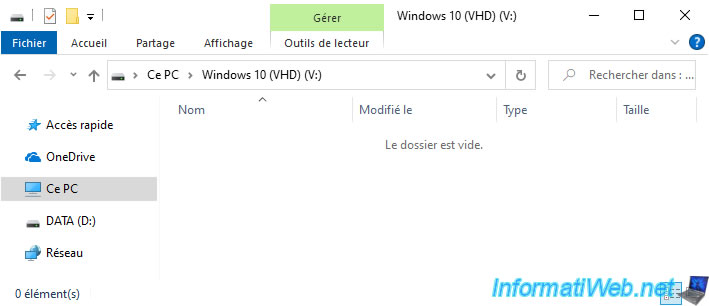
Right click "Manage" on "This PC".
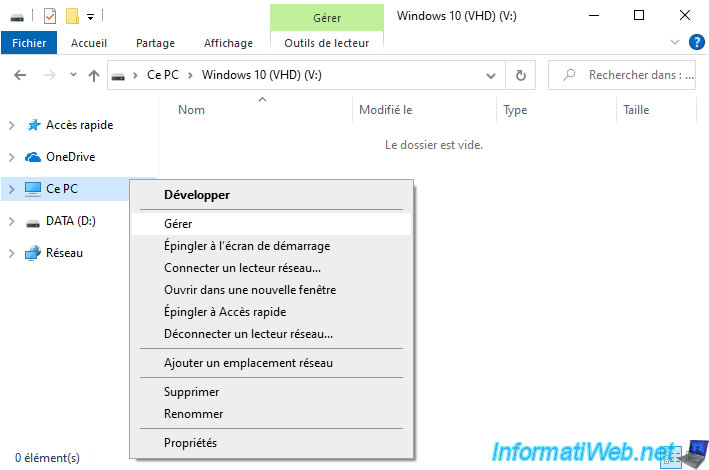
In Windows Disk Management, you will see that a new disk has appeared.
But you will notice that this disk has a turquoise blue icon instead of a gray icon.
Which indicates that it is a virtual hard disk.
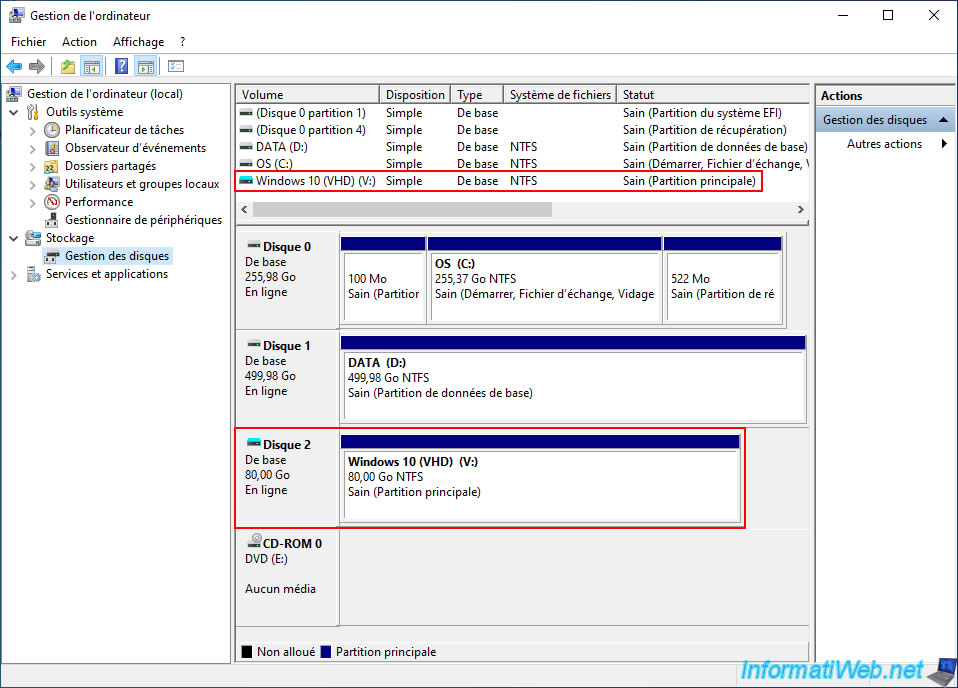
3. Copy Windows 10 installation files to VHDX virtual hard disk
To install Windows 10 on your VHDX virtual hard disk, you will need its installation DVD.
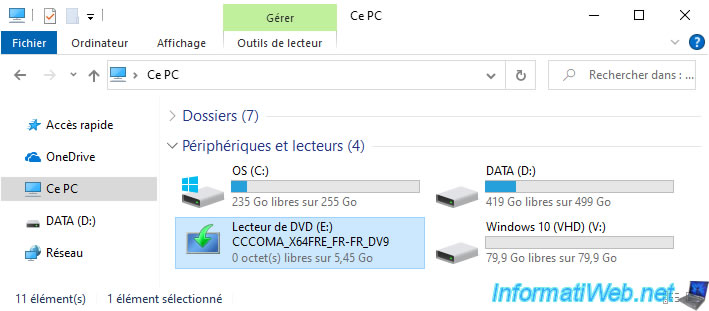
Once the Windows 10 installation DVD has been inserted into your CD/DVD drive, right-click "Open" on it.
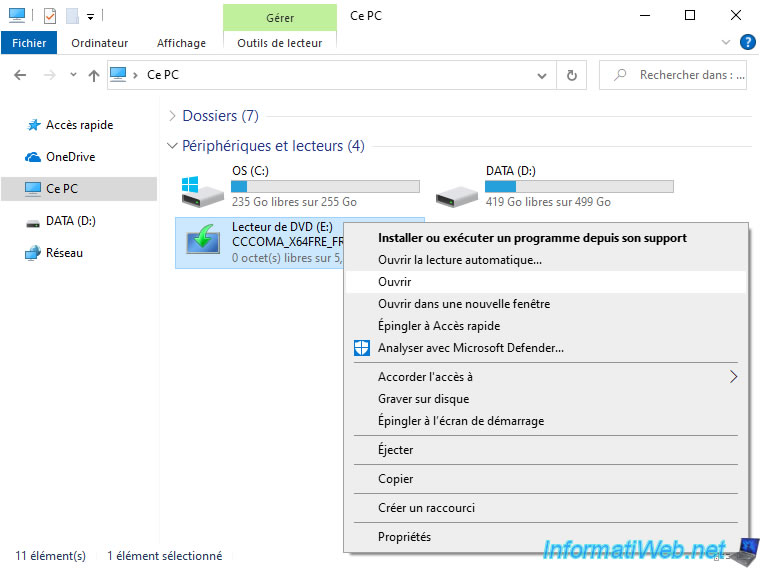
On your Windows 10 installation DVD, you will find a "sources" folder (as it is since Windows 7).
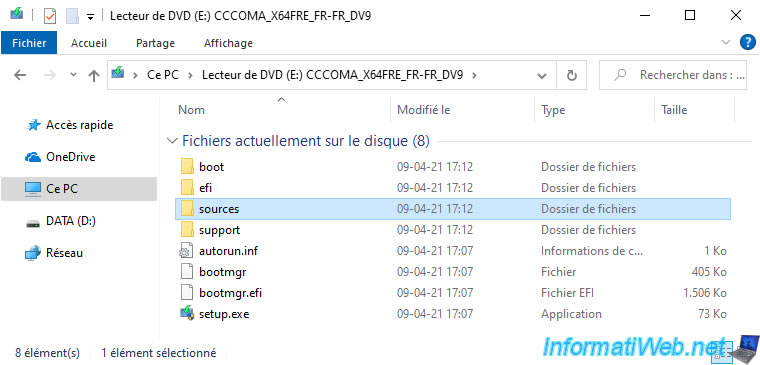
In this "sources" folder, you will find an "install.wim" file (or maybe its compressed version: install.esd).
Regardless of the format of this file, the procedure is the same.
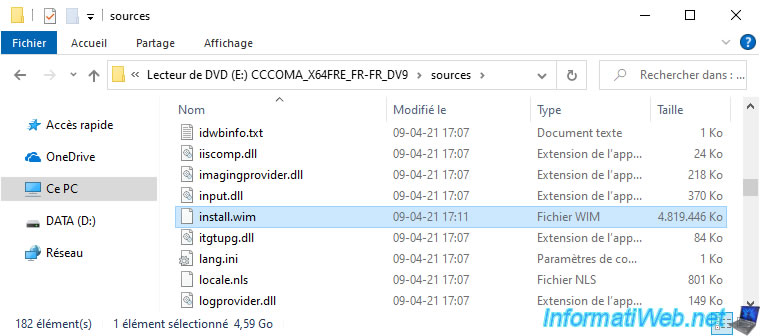
This "install.wim" (or "install.esd") file may contain one or more Windows 10 images (depending on your Windows 10 installation DVD).
Generally, there are as many images as editions of Windows 10 available on your Windows installation DVD.
To know them, use the command below.
Note: this command also works if you have the compressed version "install.esd" instead of the original version "install.wim".
Batch
Dism /Get-WimInfo /WimFile:E:\sources\install.wim
As you can see, our Windows 10 installation DVD has several editions, including the most common: Home and Professional.
Editions with an "N" at the end correspond to editions without multimedia features (Windows Media Player, ...).
Plain Text
Deployment Image Servicing and Management tool Version : 10.0.19041.844 Details for image : E:\sources\install.wim Index : 1 Nom : Windows 10 Home Description : Windows 10 Home Size : 14,836,223,545 bytes *** Index : 6 Nom : Windows 10 Pro Description : Windows 10 Pro Size : 15,091,263,759 bytes ***
In our case, we will be installing the "Windows 10 Pro" edition, so we will have to indicate the index "6" in the following command.
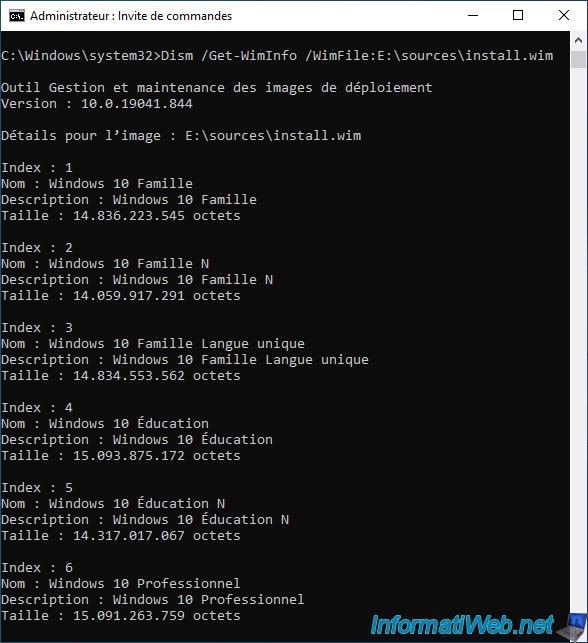
To perform the 1st step of installing Windows 10, use the command below indicating:
- /ImageFile:E:\sources\install.wim : path to the "install.wim" or "install.esd" file of your Windows 10 installation DVD.
- /Index:6 : the number (index) of the image retrieved above that corresponds to the edition of Windows 10 that you want to install.
- /ApplyDir:V:\ : the letter (in our case "V") of the partition created previously on your virtual hard disk "win10.vhdx".
Batch
Dism /Apply-Image /ImageFile:E:\sources\install.wim /Index:6 /ApplyDir:V:\
Wait while the Windows 10 image is applied to your VHDX virtual hard disk.
This may take some time depending on the physical drive the "win10.vhdx" file is located on, as well as your computer's performance.
Plain Text
Deployment Image Servicing and Management tool Version : 10.0.19041.844 Applying image [==== 7.0% ]
Once the image is applied, this will be displayed.
Plain Text
Applying image [==========================100.0%==========================] The operationg completed successfully
If you go to file explorer and click on "This PC", you will see that space is used up on your "Windows 10 (VHD) (V:)" partition.
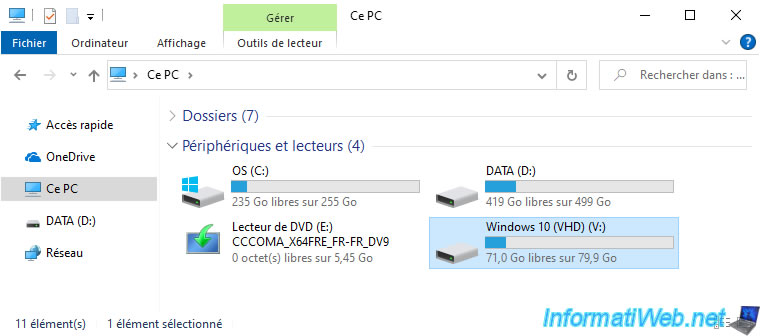
If you enter this "Windows 10 (VHD) (V:)" partition, you will see that the folders displayed are those of a standard Windows installation.
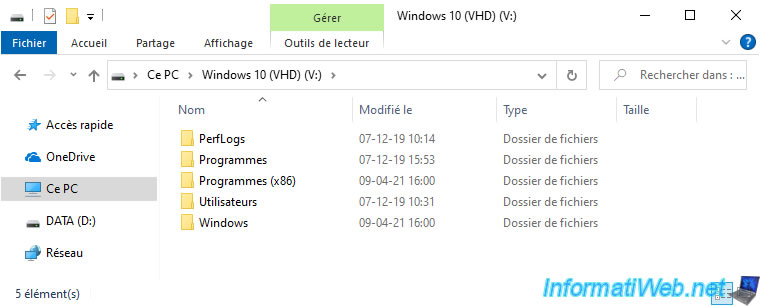
In our case, Windows 10 currently takes up 8.91 GB.
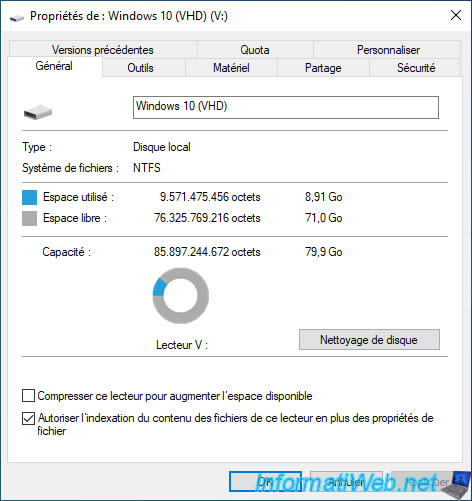
Launch the DiskPart utility.
Batch
diskpart
Select your virtual hard disk by specifying the path of its VHDX file.
Batch
select vdisk file=D:\win10.vhdx
Plain Text
DiskPart successfully selected the virtual disk file.
Detach the virtual hard disk so that Windows no longer uses it for the time being.
Batch
detach vdisk
Plain Text
DiskPart successfully detached the virtual disk file.
Quit DiskPart.
Batch
exit
In File Explorer, you will notice that the "Windows 10 (VHD) (V:)" partition has disappeared.
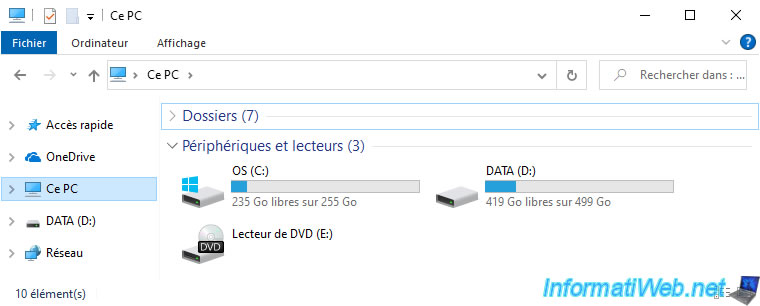
Your VHDX virtual hard disk will also be gone from Windows 10 Disk Management.

Share this tutorial
To see also
-

Windows 10/2/2023
Upgrade Windows 11 to newer version of Win 11 (from DVD)
-

Windows 8/29/2022
Windows - Install the drivers from the manufacturer's site
-

Windows 2/15/2022
Windows 11 - Formatting and reinstalling (on incompatible hardware)
-

Windows 5/29/2023
Windows 11 - Recover the start menu

You must be logged in to post a comment